If you’re looking for the best binoculars in India, you’ve come to the right place. Here, we’ll take a look at some of the best options currently on the market, and help you decide which one is right for you. Whether you’re looking for a compact option for travel, or a high-powered binocular for hunting, we’ve got you covered. So, without further ado, let’s take a look at some of the best binoculars in India!

With good binoculars you can observe nature from afar while hiking in the mountains, you can gaze at the stars or experience a theater show or concert as if you are in the front row.
There are many binoculars available on the market nowadays. Not only are there many different models, but the choice in terms of specifications is also truly boundless. It is important to be able to find the binoculars that are right for you, and that meet all the features you need.
A wide choice, however, can also prove to be a source of doubts. Which of the binoculars is really the best? We are pleased to inform you that, in this article, you will find the best binoculars in India of the moment.
List of best binoculars in India with price
If you are thinking of buying binoculars, you will find in this guide all the information you need to understand which model you should aim for and what are its most important characteristics. We have selected the ten best binoculars in India on the market for you in a handy comparison table that will help you learn more about them.
| S. No. | Best Binoculars In India | Price |
| 1. | Krevia 8×40 Binocular | Rs. 1,804 |
| 2. | CASON 8×40 Binocular | Rs. 1,639 |
| 3. | Celestron 10×50 Binocular (71256) | Rs. 4,258 |
| 4. | Haus Alchemy Binocular (Binocular-B) | Rs. 2,299 |
| 5. | ZHENGTU 10×25 Binocular | Rs. 699 |
| 6. | Nikon 10-22×50 (Aculon A211) | Rs. 13,096 |
| 7. | Olympus 10×50 Binocular (V501023BU000) | Rs. 8,851 |
| 8. | PENTAX 12×50 Binocular (SP 12 x50) | Rs. 8,799 |
| 9. | COMET 20×50 Binocular (Power View) | Rs. 2,799 |
| 10. | Bushnell 10×42 Binoculars (210142) | Rs. 7,790 |
Reviews of best binoculars in India
1. Krevia 8×40 Binocular
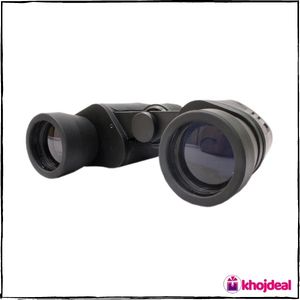
Key features & specifications
- 8×40 compact binocular
- Rugged shock proof design
- Clear image
- Suitable for both kids & adults
- Objective lens diameter: 40mm
- Wide field of view: 430ft / 1000yds
- Material: Endurable metal prism
- Water resistant
- Porro prism
- Classic design with comfortable grip
- Sharp & crispy image
- Perfect for travel, bird watching, sightseeing, wildlife watching, sports and concerts etc.
- Includes binocular, backpack, lens cleaning cloth, user manual
Things we like about this binocular
Whether you’re birdwatching or stargazing, the Krevia 8×40 binoculars have the aperture you need and the affordability you desire. It is designed for portability. It has a lightweight aluminum body with an ergonomic rubberized exterior for a firm grip. Completely water resistant, you can carry it for outdoor use with ease. One of the most important features of this Krevia 8×40 Porro binocular is its exceptionally wide apparent angle of view that enhances your viewing experience. So, if you are looking for a good quality binocular that offers excellent optical performance along with a compact size and great price, then the Krevia 8×40 Porro binocular will be a great choice.
The eyecups on the Krevia 8×40 binocular twist up and down so any viewer can see the full field and enjoy comfortable viewing—with or without eyeglasses. When not using eyeglasses or sunglasses, keep the eyecups fully extended. For the best viewing when wearing glasses, twist eyecups down. Krevia 8×40 binoculars are perfect for your outdoor adventures. They have high power magnification which provides you with clear images. Whether you’re taking the family on an extended camping trip in the mountains or just taking a day trip to a local hiking trail, this Krevia 8×40 binocular has everything you need to enjoy the great outdoors.
Pros & Cons
Pros (What we liked)
- Good handling; easy to carry
- Awesome for bird watching
- The zooming capability is very good
- Adjustment is quite easy
- Night vision is also good
Cons (What we didn’t like)
- No nitrogen filling
Customer Ratings
- Sturdiness: 3.9
- For beginners: 3.9
- Value for money: 3.9
- Picture quality: 3.8
- Sheerness: 3.5
- Night vision: 3.0
2. CASON 8×40 Binocular
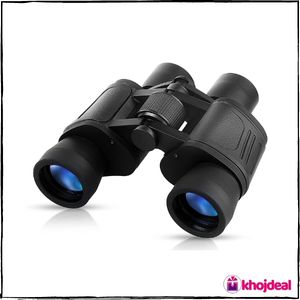
Key features & specifications
- Prism type: Porro BAK-4 Glass
- Display type: Ultra clear FMC
- Model: 8×40
- Magnification: 8X
- Objective Lens: 40mm diameter
- Field of view: 420ft or 1000yds
- Focusing system: Center + Right eyepiece diopter
- Image Stabilization
- Wide-angled view
- Compact-sized binoculars
- Sharp & crispy image
- Smooth central focus knob for quick viewing
- Antireflection tri-layer coated blue lens
- Material: Metal & Rubber
- Comfortable for extended viewing
- Alloy body covered by rubber armor
- High refractive index rate
- Includes binoculars, cleaning cloth, neck strap, carrying bag, manual
Things we like about this binocular
CASON 8×40 binoculars are a great choice for bird watching, sporting events, concerts and more. The high-quality optics of these binoculars provides an amazing viewing experience. They feature a wide-angled view with a sharp & crispy image quality. This is great for spotting animals at a distance while on safari or viewing the landscape on an outdoor hike. These compact sized binoculars are comfortable for extended viewing. The new design of the rubber armor makes it easy to hold the binoculars in your hand while you enjoy the beautiful scenery around you. You can even use them at night thanks to their bright green coating that enhances your vision during low light conditions.
The image stabilization feature reduces shakes and vibrations when you are moving. The high refractive index rate ensures that the images are crisp and clear. It has a central focus knob to quickly adjust the focus between near and far objects. The anti-reflection tri-layer coated blue lens to provide you with sharp & crispy images every time. The exit pupil distance of 23 mm allows you to get a more comfortable observation experience. The 40 mm large-aperture objective lens allows more light sources to come in, so you can also get ultra-high image brightness in low-light environment.
Pros & Cons
Pros (What we liked)
- BaK-4 prism and multi-coated blue film optics for superior resolution and image clarity
- Made with specialized engineering metal; sturdy and durable
- Handgrip has non-slip rubber armor for absorbing shock
- Comes with diopter system to adjust vision imbalance
- Large field of vision for wider images
Cons (What we didn’t like)
- Eye finder lever construction quality is poor
Customer Ratings
- Value for money: 3.8
- Easy to use: 3.8
- For beginners: 3.8
- Picture quality: 3.7
- Sheerness: 3.6
- Night vision: 2.8
3. Celestron 10×50 Binocular (71256)

Key features & specifications
- Multi-coated optics
- Ergonomic thumb indents and finger ridges
- Rubber covered aluminum body
- 117.53m field of view at 1000m
- Water resistant
- Objective lens Diameter: 50 mm
- Magnification: 10x
- Prism type: Porro
- Prism glass Type: BK7
- Eye Relief: 12 mm
- Minimum Focusing Distance: 7.01 m
- Angle of View: 6.7 degrees
- Compact size
- Stylish design
- Lightweight
- Includes binocular, carrying case, objective covers, eyepiece covers, lens cloth, instruction manual
- Ideal usage: Bird watching, hunting, sports, nature, wildlife, boat, concerts, live performances, etc.
Things we like about this binocular
A good quality binocular that offers a combination of price, size and performance is a wonderful travel companion. Celestron upclose G2 10×50 Porro binocular is at the forefront in this category. It is ideal for all types of use, be it terrestrial viewing, leisure, or star gazing. It is one of the rare binocular models that offer the features of higher priced models without the high price tag. The compact size and stylish design make it ideal to carry anywhere. Also, the Celestron 71256 is lightweight and can be used for longer time periods.
Magnification is often one of the most sought-after features while selecting a binocular. But the objective of the lens is equally important especially in low light conditions. The Celestron Upclose G2 offers a combination of the two. It has a 10x magnification range combined with a 50 mm aperture that allows incredibly bright images even during low light conditions like dawn or dusk. A BK7 Porro prism and multi-coated lenses in the Celestron Upclose G2 10×50 ensure that each image shows immaculate detail, vivid colors, and excellent contrast.
Pros & Cons
Pros (What we liked)
- Multi-coated optics increase light transmission resulting in brighter and sharper images with high contrast levels
- Ergonomic thumb indents and finger ridges for extra non-slip comfort and ease of use
- Lightweight aluminum body with an ergonomic rubberized exterior for a firm grip
- Good for landscape and birdwatching
- Zoom is accurate and very clear
Cons (What we didn’t like)
- No night vision capability
Customer Ratings
- Easy to use: 4.0
- For beginners: 4.0
- Value for money: 3.8
- Sheerness: 3.8
- Stability: 3.8
- Picture quality: 3.7
4. Haus Alchemy Binocular (Binocular-B)
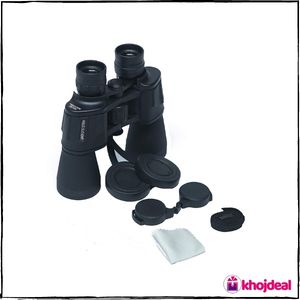
Key features & specifications
- 20x Magnification
- 50mm Wide-angle lens
- Visibility up to 1000 meters
- Smooth central focusing wheel
- Diopter adjustment ring on right eyepiece
- Made of ABS plastic
- Non-slip rubber armor
- Shockproof
- Water resistant
- Compact and lightweight
- Tripod mount
- Neck strap clip
- High-definition picture quality
- Rapid focusing
- Long life guaranteed
- Includes binocular, carry case, secured lens caps, cotton cloth, neck strap, instruction manual
Things we like about this binocular
Haus Alchemy for adults has a 20x magnification and a 50mm objective lens, letting you see more distant objects with wider field of view. The BAK4 prism and multi-coated optics provide superior image resolution and clarity, while the central focus system makes it easy to sharpen your view. Multi-layer coating lens coating reduces the reflected light in the objective lens and improves light transmission, image brightness and image sharpness. The rubber covered eyepiece can be twisted up and down to adjust the most suitable distance between the eyes and the optical lens. The eyeglass wearers can adjust the eye relief through rising eye cups and feel more comfortable.
Built small and lightweight, this binocular is a perfect choice for camping, hiking, concerts, bird watching, traveling, golfing, sporting events. The binoculars have diopter adjustment ring on the right eyepiece and are designed with non-slip rubber armor that helps protect them against shock and water damage. The smooth central focus wheel and right eyepiece focus ring provide precise and fast focus control, which is very suitable for beginners. The wide-angle lens is specially designed for observing fast moving objects and this is why these binoculars are very popular with bird watchers. If you are also a nature enthusiast and are looking for the best binoculars for value for money, this is the right one!
Pros & Cons
Pros (What we liked)
- Zoom and wide-angle lens help obtain high resolution and high contrast views
- Compact and lightweight enough to carry in your bag or backpack
- Works well in the night-time
- Picture is very crisp, and field of vision is great
- Ideal for bird watching and nature viewing
Cons (What we didn’t like)
- Zoom doesn’t seem to be 20x; its 9x at most
Customer Ratings
- For beginners: 3.5
- Picture quality: 3.5
- Night vision: 2.5
5. ZHENGTU 10×25 Binocular
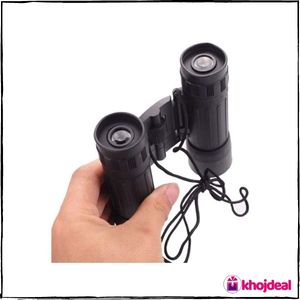
Key features & specifications
- 10×25 mm binocular
- 307ft field of view at 1000m
- Durable rubber armoring
- FMC Broadband coating
- Premium BAK4 prism
- 10 x magnification
- 25 mm objective lens
- Made of high-quality materials
- Waterproof
- Shock resistant
- Wide angle of view: 5.8-degree
- Exit-pupil distance: 20mm
- Exit-pupil diameter: 2.4mm
- Ideal for bird watching, walking, climbing, boating/yachting, travel, etc.
- Includes binoculars, carrying pouch, cleaning cloth, strap, user manual
Things we like about this binocular
The BAK4 prism of ZHENGTU 10×25 binocular has a high light refractive index, which can avoid light loss and black edges effectively, bring you a clear, sharp, and stable vision. The body is covered with no pungent odor rubber and O-ring seal design, so that ZHENGTU binoculars have good waterproof, anti-fog, and non-slip performance. For better brightness and clarity, ZHENGTU binoculars are equipped with fully multi-layer green-coated (FMC) aspheric lenses, the light transmittance of which can reach 99.8%. The ability to attach these binoculars to a tripod is a godsend.
ZHENGTU binoculars have a field of view of 307ft at 1000 meters, helping you to easily find a target 1000 meters away in a stable and comfortable environment. Distinguished by a light design and a contemporary style, it offers comfort and simplicity of each use to capture the details of every outdoor activity. It is particularly suitable for outdoor enthusiasts who love to observe the landscape during activities such as trekking, hiking, and boating. The package also includes the case, the strap to carry the binoculars over the shoulder and the protective caps.
Pros & Cons
Pros (What we liked)
- Ruby-coated optics for maximum light even in low light conditions
- Smooth center focusing for easy usage
- Adjustable eye mask can be easily twisted up or down for optimal viewing
- Comes with very good quality carry pouch
- Vision and clarity are superb given the price range
Cons (What we didn’t like)
- Very tiny lenses; can’t look through them long without getting dizzy
Customer Ratings
- Sheerness: 4.2
- For travelling: 4.1
- Sturdiness: 4.0
- Value for money: 3.9
- Light weight: 3.8
- Easy to use: 2.0
6. Nikon 10-22×50 (Aculon A211)
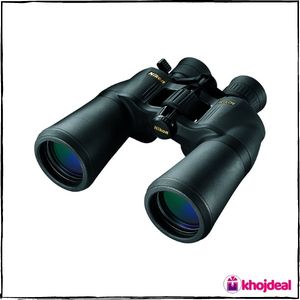
Key features & specifications
- Aspherical multicoated eco-glass lenses
- Non-slip grip
- Focusing System: Central Focus
- Magnification: 10 -22 x
- FOV at 1000 yds: 199 ft
- Close Focus Distance: 49.2@10x ft
- Exit Pupil: 2.3 -5 mm
- Relative Brightness: 25@ 10 x
- Eye Relief: 8.6 mm@ 10 x
- BaK4 high index Porro style prisms
- Turn-and-slide rubber eyecups
- Fingertip zoom control
- Ergonomic lightweight design
- Durable and protective rubber-armored coating
- No-Fault Repair/Replacement Policy (TnC apply)
Things we like about this binocular
A triad of optical technology is integrated into the ACULON A211 binoculars. The unique zoom feature delivers a wide range of magnifications that can be quickly tailored to the situation, while lens multicoating enhances image brightness. The Nikon Eco-Glass lenses deliver astonishing clarity and precision in a lighter-weight, lead, and arsenic-free glass composition. The fast and smooth range of focus allows for quick viewing in addition to the ACULON A211 line’s comfortable and ergonomic design. The eyepiece mounted Zoom Lever allows fast magnification changes from 10x through 22x.
ACULON A211 10-22×50 zoom binoculars are built to handle virtually any environment you can bring them into. No matter what the weather conditions may be, you will always have a sure, non-slip grip on your binoculars, making them one piece of equipment you can always count on to perform. The turn-and-slide multi-click rubber eyecups allow users to adjust the eye relief for a custom fit—providing a full field of view and maximum comfort during extended periods of use. All together the ACULON A211 10-22×50 zoom binoculars are a quality, cost effective choice.
Pros & Cons
Pros (What we liked)
- Multi-coated eco-glass lenses deliver a bright and clear image in most lighting conditions
- A durable rubber-armored coating ensures a non-slip grip even in wet conditions
- Easy-to-reach fingertip zoom control knob allows for quick and easy adjustment of the magnification
- The night-time performance is flawless as well
- Manufactured responsibly with lead and arsenic-free Eco-Glass
Cons (What we didn’t like)
- They are a little bulky while traveling and feel heavy around the neck
Customer Ratings
- Easy to use: 4.5
- For beginners: 4.4
- Picture quality: 4.4
- Value for money: 4.2
- Sheerness: 4.1
- Low light: 4.0
7. Olympus 10×50 Binocular (V501023BU000)
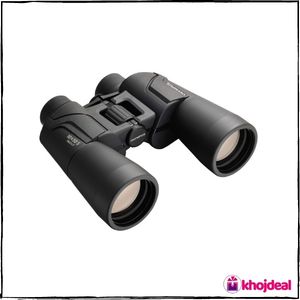
Key features & specifications
- Wide field of view
- High-performance optics
- High-quality finish
- Robust housing
- Sure-grip rubber coating
- Coated lenses and prisms
- Large, intuitive to use, easy to reach focus wheel
- Comfortable operation
- Maximum comfort, functionality, and portability
- Compact, lightweight size
- Ergonomic controls
- Type: Porro‑prism series
- Magnification: 10x
- Apparent angle of view: 59.2-degree
- Field of view at 100m: 11.3m
- Relative brightness: 25
- Diopter adjustment range: over +/‑ 2 1/m
- Eye interval adjustment range: 60 ‑ 70mm
- Objective lens diameter: 50mm
- Closest focal point: 6m
- Eye relief: 12mm
- Ideal for bird watching, hiking, nature, traveling, sports/events
- Includes binocular, rubber eyepiece, lens cover, soft carrying case, strap
Things we like about this binocular
Olympus Standard binoculars are the perfect companion for observing nature, sport, wildlife, and birdwatching. A wide field of view makes locating a subject quicker and easier, particularly when panning a wide area or tracking fast-moving subjects, such as birds, animals, and action sports. The large objective lens diameter offers bright high-resolution images even in low light. Advanced optical technologies including aspherical lenses plus coated lenses and prisms ensure a high level of optical performance by reducing image distortion and chromatic aberration for sharp images and a clear field of view with superb transmittance.
A Porro prism enables a wider space between the left and right objective lenses, delivering the stereoscopic view unique to binoculars. A focusing distance as close as 6m allows you to follow animals almost motionless as they approach without being detected. With a durable, high-quality finish, robust housing resisting any nature conditions and a rubber coated grip ensuring a safe hold these binoculars are well equipped for outdoor use. Maximum comfort, functionality and portability is granted thanks to the slim, simple design and ergonomic controls. All elements have been arranged precisely for a compact size, resulting in a sharp impression and a lightweight body.
Pros & Cons
Pros (What we liked)
- Wide field of view optimal for tracking fast-moving subjects
- High-performance optics provide a bright, clear field of view
- Superb transmittance and sharp, high-resolution images
- Minimal distortion and chromatic aberration even in low light conditions
- A rubber coated grip ensures a safe hold for easy and comfortable operation
Cons (What we didn’t like)
- Somewhat heavy
Customer Ratings
- For beginners: 5.0
- Picture quality: 4.3
8. PENTAX 12×50 Binocular (SP 12 x50)
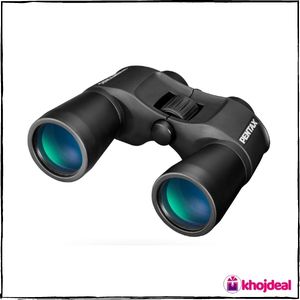
Key features & specifications
- BAK4 Porro Prisms
- Fully multicoated optics
- Wide-angle of view: 67 degrees
- Closed bridge configuration
- Slip-resistant rubberized armoring
- Center focusing
- Tripod mountable
- Fold down eyecups
- Relative brightness: 17.6
- Field of View (at 1.000 m): 98m
- Close focus: 9m
- Exit Pupil: 4.2mm
- Eye Relief: 11mm
- Closed bridge configuration
- Large, knurled center focus wheel
- Right-eye diopter adjustment
- Waterproof; submersible up to 1m
- Nitrogen-filled (JIS Class 6)
- Includes binocular, neck strap, carrying case, objective lens caps, eyepiece caps
Things we like about this binocular
Pentax’s 12×50 S-Series SP Binocular features large oversized fully multicoated 50mm objectives to reduce reflection and maximize light transmission through the entire optical path. Utilizing the traditional Porro prism configuration gives scenes a rich depth of view for an immersive observation experience and provides a comfortable feel in the hand with a lot of surface area to maintain a sure grip. The large objectives maximize the amount of light getting to the user’s eyes for exceptional low-light capabilities, and its high 12x magnification provides an immersive observation experience whether users are bird watching or comet hunting.
Premium multi-layer coatings assure the maximum light transmission through the binocular. The result is bright, crisp, true-to-life images in the widest range of viewing conditions. Additionally, a specialized protective coating repels dust, water, and grease to keep the optics clean and the image quality at its peak. Rigid body construction makes these binoculars extremely rugged to maintain optical alignment. This ensures comfortable viewing throughout the life of the product. These superior quality full sized binoculars are ideal for the widest range of lighting and weather conditions.
Pros & Cons
Pros (What we liked)
- Large objective lenses incorporated in the design allow for contrast-rich, bright viewing under all light conditions.
- Rubberized armoring protects against impacts and provides slip-resistant grip
- Fold-down rubber eyecups seal against ocular cavity and block stray peripheral light
- Waterproof and nitrogen filled (JIS Class 6) to handle the most extreme weather conditions
- Reinforced chassis is extremely rigid, but light enough to carry anywhere
Cons (What we didn’t like)
- Cover caps for the objective and eyepiece are loosely attached
Customer Ratings
- NA
9. COMET 20×50 Binocular (Power View)
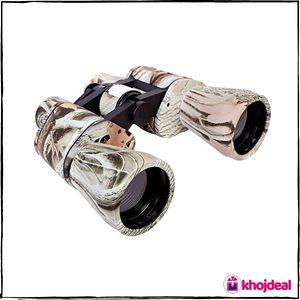
Key features & specifications
- Magnification: 20x
- Objective Lens: 50mm
- Field of View @1000yds: 168 Ft
- Field of View @1000m: 57m
- Close Focus: 45ft or 13.7m
- Eye Relief: 9mm
- Exit Pupil: 2.5mm
- Porro Prism Bk7 Glass
- Center focus knob
- Right eye piece fine tuning
- Multi-coated optics
- Beautiful design
- Built to last
- Non-slip rubber armor
- Water and shock resistant
- Manual focus
- Includes binocular, lens cloth, carrying bag, lens caps
Things we like about this binocular
Among the best-selling Comet binoculars, we find this model with really interesting performances, ideal for accompanying excursions in the middle of nature to fully enjoy every detail around. This one is an all-purpose binocular that offers a combination of durability, precision and versatile style that will make the most of your time outdoors. Some of the great features that has this excellent binocular are 20x magnification with 50mm objective lenses, high quality BK-7 prism multi-coated optics for bright, clear, and crisp viewing, camouflage non-slip rubber armor that absorbs shock at the same time provide a firm grip.
This binocular is equipped with a comfortable carrying strap and a special protective case and is suitable for use even on the move thanks to the firm rubber grip. It is perfect for observing nature and can also be used without eyeglasses, according to users. Thanks to its compact and foldable design, and weighing just 280 grams, it can be taken anywhere. The integrated tripod connection gives you the option to mount it on a stand to ensure maximum stability. Finally, the Power View 20 x 50 is a great binocular and also a great value for the money.
Pros & Cons
Pros (What we liked)
- Non-slip rubber armor absorbs shock while providing a firm grip
- Quality optics with stunning HD clarity
- Good for beginners
- The carry case provided with shoulder straps is very useful while travelling
- 6 Months replacement warranty against manufacturing defect or if damaged product is received
Cons (What we didn’t like)
- Night vision could have been better
Customer Ratings
- For beginners: 4.5
- Value for money: 4.0
- Picture quality: 4.0
- Sheerness: 3.5
- Night vision: 2.8
10. Bushnell 10×42 Binoculars (210142)
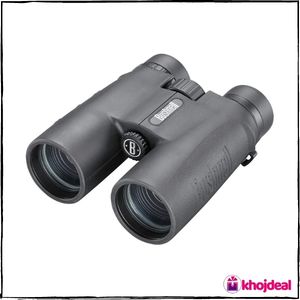
Key features & specifications
- Adapts to Tripod
- Close Focus: 12ft / 4m
- Exit Pupil: 4mm
- Eye Relief: 19mm
- Eyecups: Twist-up
- Lead Free Glass
- Length: 132mm
- Lens Coating: Multi-Coated
- Magnification: 10x
- Objective Lens: 42mm
- Prism Glass: BaK-4
- Prism Type: Roof
- Water Resistant ; IPX7
- FOV (@1000yd) 305ft
- FOV (@1000 m) 102m
- Protective Lens Coating: EXO Barrier
- Attached front lens caps
- Adjustable diopter
- Nitrogen purged
- Center focus wheel
- Includes binocular, padded neck strap, carrying case, Spudz cleaning cloth, rear lens caps
Things we like about this binocular
Prime 10x42mm binoculars provide rich features and a lifetime warranty at a competitive price. They come with fully multi coated optics to increase light for a brilliantly bright picture. BAK4 prisms are used to increase brightness even further. To guarantee the weather elements don’t get in the way, these Prime 10×42 binoculars come with EXO Barrier lens coating to shake off water, dust, and debris. Additionally, these binoculars are IPX7 fully waterproof to inspire confidence in the field. They also have a full, transferable, lifetime Ironclad Warranty so you can buy with confidence.
An ergonomic design and center focus wheel get you on target and fine-focused in an instant, while twist-up eye pieces accommodate users with eyeglasses. They are nitrogen-purged to resist fogging for superior clarity. The adjustment dials turn smoothly, and calibration is easy to achieve by following the steps in the user manual. The view is very bright and clear and the 10X magnification is more than adequate. All Prime binoculars come with a belt-mountable soft case to protect your investment and make carrying effortless. Also in the box is a rear lens cap and a comfortable neck strap.
Pros & Cons
Pros (What we liked)
- Protective lens coating molecularly bonds to the glass, repelling water, oil, dust, debris and preventing scratches
- O-ring sealed optics stay dry inside, when immersed in three feet of water for up to 30 minutes
- Multiple layers of coatings on all lens surfaces increase light transmission and image brightness
- Excellent in low light situations
- Very solid durable construction
Cons (What we didn’t like)
- The outside material of the binocular has a very strong and nauseating plastic smell initially
Customer Ratings
- NA
How to choose the best binoculars in India?
You have been thinking about buying binoculars for a long time, but you have no idea how they work or which ones would be ideal for your needs. This handy guide on how to choose the best binoculars in India will help you in your search until you find the right one! The first thing to do is undoubtedly become familiar with the technical language and these basic features will make you understand the different potentials.
1. Use of binoculars
The optics you choose will depend on the use you intend to make of the binoculars. Some models are suitable for observing birds and natural elements, while others also integrate a night vision system, while still others are excellent theater binoculars. For this, it is essential to check the number of enlargements and the diameter of the objective lenses, because on the basis of these factors, the brightness of the enlarged image and the width of the field of view depend.
Recognizing these data is very simple. Generally, after the name of the product some numbers are inserted (for example 8 × 42) which represent the number of enlargements and the diameter of the lenses in millimeters. We can divide the types of binoculars according to the following uses:
- Hunting: For hunting we recommend fully rubber coated, waterproof and fog-free models with a magnification of 7x to 10x for general hunting or 12x to 16x for long range sports. Compactness is essential for hunters on the go.
- Bird watching: 8 × 42 binoculars are the standard for bird watching enthusiasts, but 10 × 42, 10 × 50 and 12 × 50 models are required for detailed observation of smaller and more distant species. Compact binoculars with 30mm diameter are recommended.
- On a boat: Any waterproof model with a large lens diameter and rubber coating. Preferable types are 7 × 50, 7 × 42, 8 × 42, and 10 × 42.
- Concerts / theaters: Wide angle 5 × 25 and 8 × 25 binoculars are preferred, or compact 4 × 30, 7 × 18 and 7 × 21 models.
- Outdoors: Any 7×35, 7×50, 8×42 and 10×42 will be perfect. Among the compact ones we suggest the 8 × 30 and 10 × 30. We also recommend waterproof models for camping.
- General use / vacation / excursions: For general use with limited needs, we suggest 7 × 35, 8 × 42, 10 × 42 and 10 × 50 binoculars, compact and wide angle.
2. Type of prisms
The prisms are particular reflecting and refracting elements that have the purpose of straightening the image through a series of refractions. Basically, the prisms that can be found on binoculars are two types, each of which with its own advantages and disadvantages:
- Porro prisms
- Roof prisms
Porro prisms are those made with the greatest constructive simplicity and, precisely for this reason, they represent the least expensive choice. With this type there are fewer refractions, and less light is dispersed. As a result, you will have a brighter image. Unfortunately, however, this type of prism is decidedly heavier and bulkier, and carries with it a significant bulk even in width.
Roof prisms, on the other hand, take their name from their characteristic shape and are technically more complex than those of Porro, because they use a greater number of surfaces that must be positioned with absolute precision. For this they are more expensive, but also smaller and lighter.
Generally, in small binoculars and with low magnification (up to a maximum number of 8x) roof prisms are used, while in larger binoculars Porro prisms are used.
3. Lens material
The material with which the lenses are made is one of the factors that determines their quality. Generally, the lenses of binoculars are made of glass, but two types of glass are used on the market:
- BAK7: The lenses in this category are made of borosilicate glass, a type particularly appreciated for its resistance and high degree of transparency.
- BAK4: The lenses in this category are made using a Crown-barium glass, which is distinguished by a low refractive index and low light scattering. Basically, it is the best type of glass for the production of scopes, which makes it more expensive than the BAK7.
4. Anti-reflective treatment
Generally defined with the term “coating”, the anti-reflective treatment that the lenses have received is another factor to be taken into consideration. On the market you can find four different types of anti-reflective treatment, which are distinguished by characteristics and price:
- Coated (C): A single layer of anti-reflective coating has been applied to the outer surfaces of the objective and eyepiece lenses.
- Multi Coated (MC): Multiple anti-reflective layers have been applied to the outer surfaces of the lenses. This statement does not specify the number of layers applied.
- Fully Coated (FC): A single anti-reflective layer has been applied to the external and internal surfaces of the lenses, as well as to the external surfaces of the prisms.
- Multi Fully Coated (MFC): All surfaces of the lenses and the outer surfaces of the prisms have been treated with multiple anti-reflective layers. However, the number of layers applied is not specified.
A single application of the anti-reflective layer can reduce light scattering and bring it to 5%. The application of multiple layers can lower the dispersion even bringing it to 0.25%.
5. Phase correction
Phase correction is a factor to be considered only in models using roof prisms. It is a corrective layer applied to the optics that reduces the problems of distortions due to the constructive complexity of the prisms. This particular process substantially restores the image quality and relative sharpness, which could undergo variations due to the large number of prisms used.
6. Brightness and exit pupil
The brightness of the binoculars is expressed under the words “brightness index”, or “pupil exit”. It is a very important factor that depends on the combination of magnification and lens diameter and basically represents the amount of light that enters the device and that that comes out of the eyepieces.
The diameter of the exit pupil, i.e., the image seen from the eyepiece by positioning the telescope at a distance of about 30 cm, depends on the ratio between the diameter of the lenses and the number of magnifications. It is therefore important to always check that the exit pupil is consistent with the specifications of the chosen model and the relative magnifications and diameters: for example, if a 10 × 50 binocular has an exit pupil of less than 5 mm in diameter, it means that the diameter of the lens is not actual 5 cm as stated.
Binoculars with a large exit pupil will allow the observation at dusk of things that you would not be able to see with the naked eye and is particularly suitable for astronomical observation. If instead you want to use the apparatus for observing animals, birds, and excursions, you might consider buying a model with a brightness effect between 3 and 4.
To transmit enough light to the eye to allow vision, binoculars for night use must exceed 6 mm in diameter of the exit pupil but not surpass 7 mm. Twilight binoculars should be at least 5 mm in diameter, and daytime binoculars should be at least 3 mm in diameter.
7. Field of view
The field of view is another factor to consider before buying which basically depends on the number of possible enlargements. When it is expressed, the maximum distance observable from your position is indicated, for example 1000m, 100m, 400m, etc. And it is on the basis of this factor that another very important thing must be considered: the greater the magnification power of the binoculars, the more restricted will be the portion of land that it allows you to observe.
If you want to observe animals with a discreet level of detail, you will need a good number of enlargements, resulting in a loss of field of view. If, on the other hand, you want to be able to follow a moving animal within a rather wide panorama, you may prefer binoculars with less than 10 magnification and consequently with a wider field of view.
8. Eye relief
This adjustment performs a double function. On the one hand it allows you to place the binoculars on your face, shielding the eye from sunlight, on the other hand it allows you to precisely match the outgoing pupil with the pupil of the observer. This second function is the most important for a correct vision of the image transmitted by the binoculars, especially in changing lighting conditions.
As the size of your pupil changes, the pupil extraction will also have to vary. The adjustment is obtained through two soft cups placed on the eyepieces, removable and adjustable to the desired length. There are two types of possible eye relief adjustments:
- Removable cup: The most customizable, since the cups can be more or less extracted with a screwing movement, lengthening or shortening the eye relief.
- Collapsible cup: Less versatile, the cups can be folded in only two positions, closed on the tubes, therefore with zero eye relief, or “open”, with fixed distance eye relief.
Unfortunately, many low-end models are completely devoid of eye relief, and therefore force the user to keep the binoculars at the right distance with greater effort and discomfort. For this reason, we recommend not to underestimate this apparently insignificant detail.
9. Dioptric adjustment
This adjustment is often present even in the cheaper models and is important to correctly focus the image with both eyes. All have differences in sight from one eye to another, some more accentuated, some less, and it is therefore necessary to adjust the focus separately for the two eyepieces from the first use.
The diopter adjustment ring is typically located on the right eyepiece, and the procedure for adjusting the focus is very simple. We recommend checking the presence of this adjustment particularly for those who already know they have significant differences in sight between the two eyes.
10. Focus
The focus serves to visualize the object you want to observe in the clearest possible way and is achieved through a special wheel. In most cases, the focus is central, meaning that the adjustment wheel is placed between the two tubes, easily accessible by the hands holding the binoculars.
However, in some cases, the focus is independent, meaning that each eyepiece has an adjustment ring, and the focus is adjusted independently. Requiring more time than central focusing, this type of focusing is not very suitable for naturalistic observation situations, in which it is necessary to quickly focus the observed subject.
Some models also have automatic focus. These are fixed focus models in which the depth of field is such as to be able to view objects at close range up to infinity. This type of binocular is immediately ready for use without having to focus and therefore ideal for observation in the open field, particularly for marine use, or for observing fast moving subjects.
11. Interpupillary distance
The interpupillary distance is the distance between the center of one pupil and the center of the other. In order to use binoculars correctly, it is naturally necessary that the eyepieces of the instrument can align perfectly with our pupils. It is difficult to find binoculars that cannot be folded to bring the eyepieces closer or further away. However, we still recommend that you do not take anything for granted, not even details like this that may seem the most obvious.
12. Dimensions and weight
The dimensions are another very important factor to consider because they considerably affect the practicality of use of the binoculars. And the choice of this factor also depends on the type of use to be made of it. On the market you can find pocket binoculars, small and not very heavy, or larger models much more uncomfortable to carry.
Clearly the choice between these possibilities varies from person to person, but our advice is to always aim for light models, but at the same time suitable for your use. With binoculars that are too heavy, prolonged use will become difficult, not to mention transport.
13. Robustness
It is of fundamental importance that the binoculars you choose are able to withstand any exposure to the elements, possible falls and contact with dirt.
- Waterproofing: Any binoculars worthy of the name should at least be waterproofed. Otherwise, there is a constant risk that dust or water will filter inside the instrument tubes and remain there, compromising vision. The water inside the binoculars can in fact blur the vision and once evaporated, leave halos on the lenses. The sand or earth may stick to one of the internal surfaces and in turn generate halos, or permanent dark areas on the image. Therefore, we strongly recommend that you do not buy binoculars that are not perfectly waterproof.
- Filling: Another possible problem that can arise when using binoculars outdoors, particularly in conditions of high temperature range, is internal condensation. In air-filled binoculars this problem can often occur and is solved by waiting for the condensation formed inside the tubes to return to the gaseous state. A good instrument will be filled with gases not subject to the problem of condensation and in most cases the gas used is nitrogen. We therefore recommend checking on the technical data sheet whether the filling is anti-condensation or not.
- Coating: Finally, it is important that binoculars to be carried outdoors can withstand external stresses, such as accidental knocks and falls. This is why, it is important that the pipes are coated with a good layer of materials capable of absorbing shocks, such as soft rubber. This material also has an important anti-slip function, which allows a good grip even when you are in the rain or if your hands are a little sweaty.
14. Accessories
Do not forget to evaluate the accessories that will be provided with the purchase of the binoculars. These can be very important for carrying, storing, and using your binoculars safely, so we recommend that you choose binoculars that have at least one accessory kit including the bare minimum:
- Case: It can be soft, semi-rigid or rigid, and the preference depends on the use you will make of your binoculars. Better a hard case for transport inside backpacks or suitcases, while to store the binoculars in a drawer after use, a semi-rigid case may suffice.
- Shoulder strap: Essential to always have binoculars at hand, it should ideally be comfortable. If you are not satisfied with the one supplied with the purchase, you can always buy a separate one to your taste.
- Lens Covers: This accessory is a little rarer to find in basic supplies, but it’s very important to protect your lenses from dirt and scratches. In some models they can be attached to the binoculars by means of a cord which prevents them from being lost.
- Cleaning kit: In most cases the standard supply includes a microfiber cloth for cleaning the lenses. You can buy solutions and tools for more thorough cleaning separately.
Other accessories are usually bought separately, as needed. For example, it may be necessary to purchase separately mounts for fixed supports, if the binoculars do not have one integrated, and a tripod, if you want to dedicate yourself to observation from a fixed position. On the other hand, for those who are mainly used outdoors, it may be interesting to get rain protection, which prevents the accumulation of water in the eyepieces.
15. Brand
On the market there are many binoculars on sale, produced by many very famous companies in the sector. The brand is not essential, but it is still a factor that guarantees the quality of the binocular and the materials with which it is made. Among the brands that produce top-of-the-range binoculars we mention Nikon, Leica and Zeiss, or Canon, Bushnell, and Vortex which, in addition to making quality products, ensure customers excellent assistance: a factor that should not be underestimated.
Frequently asked questions about binoculars
1. What are binoculars?
Binoculars are an optical instrument that allow you to observe the magnified image of a subject from a distance. They were born from the idea of creating an instrument similar to a telescope, but usable with both eyes. The first models appeared in 1645 and were nothing more than two telescopes side by side. In this way it was possible to obtain a clearer and brighter vision. The instrument underwent an evolution until 1854, when it was perfected as we know it today by the Genoese engineer Ignazio Porro.
2. What are the best binocular brands in India?
The best binocular brands in India are Nikon, Canon, Olympus, Bushnell, and Pentax.
3. What is the interpupillary distance in binoculars?
It is the distance between the center of one pupil and the other. To use the binoculars correctly, you need to be able to align the eyepieces in the best way with respect to your pupils. That’s why almost all binoculars are adjustable, allowing you to move the eyepieces closer or further away from each other depending on the distance of the user’s pupils.
4. How does focusing work in binoculars?
Focusing allows you to see an object more clearly. It is adjusted by means of a wheel usually placed in the central part of the binoculars between the two telescopes. Some binoculars offer independent focusing for each eyepiece, which has its own adjustment wheel, which is very useful especially for people who have differences or vision defects between one eye and another.
5. Can binoculars be used with glasses?
Although in general it is best to remove the glasses before using the binoculars, taking advantage of its focus to get a clear vision, people who suffer from optical disorders can still keep their glasses. But generally, it is better to unscrew the rubber shells of the eyepieces.
6. What is the best magnification for binoculars?
If you just want general purpose binoculars, 7x to 10x magnification binoculars are best. These will give you adequate magnification for most tasks and won’t be destabilized if your hand shakes slightly.
7. What do the numbers on the binoculars mean?
Binoculars are often specified by a set of numbers such as 7 × 35 or 8 × 40. The first number indicates the magnification intensity (how many times the subject is closer to you: 5 times closer, 7 times closer, 10 times closer) and the second number is the size of the lens measured in millimeters.
Conclusion
If before reading this practical guide you had no idea how to choose a binocular among the various types on the market, now you should no longer have any doubts!
You know the models, the features, the strengths, and you have read the reviews so now you have no more excuses, you know very well which one to choose. So don’t waste any more time and proceed with the purchase of the best binoculars in India for you.
We guarantee you won’t regret it!
